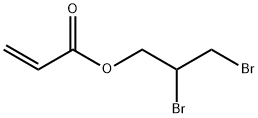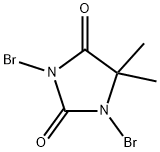2,3-DIBROMOPROPYL ACRYLATE
- CAS NO.:19660-16-3
- Empirical Formula: C6H8Br2O2
- Molecular Weight: 271.93
- MDL number: MFCD00059461
- EINECS: 243-208-9
- SAFETY DATA SHEET (SDS)
- Update Date: 2024-12-18 14:07:02

What is 2,3-DIBROMOPROPYL ACRYLATE?
General Description
Clear light brown liquid.
Air & Water Reactions
2,3-DIBROMOPROPYL ACRYLATE may be unstable to heat, light and air.
Reactivity Profile
A halogenated ester. Esters react with acids to liberate heat along with alcohols and acids. Strong oxidizing acids may cause a vigorous reaction that is sufficiently exothermic to ignite the reaction products. Heat is also generated by the interaction of esters with caustic solutions. Flammable hydrogen is generated by mixing esters with alkali metals and hydrides.
Health Hazard
ACUTE/CHRONIC HAZARDS: 2,3-DIBROMOPROPYL ACRYLATE is toxic by ingestion and has hazardous decomposition products. It is probably an irritant.
Properties of 2,3-DIBROMOPROPYL ACRYLATE
| Boiling point: | 112/1.2mm |
| Density | 1,77 g/cm3 |
| refractive index | 1.5230-1.5260 |
| form | clear liquid |
| color | Colorless to Light yellow to Light orange |
| Stability: | Stable. Incompatible with strong oxidizing agents. |
| CAS DataBase Reference | 19660-16-3(CAS DataBase Reference) |
| EPA Substance Registry System | 2,3-Dibromopropyl acrylate (19660-16-3) |
Safety information for 2,3-DIBROMOPROPYL ACRYLATE
| Signal word | Warning |
| Pictogram(s) |
 Exclamation Mark Irritant GHS07 |
| GHS Hazard Statements |
H315:Skin corrosion/irritation H319:Serious eye damage/eye irritation |
| Precautionary Statement Codes |
P264:Wash hands thoroughly after handling. P264:Wash skin thouroughly after handling. P280:Wear protective gloves/protective clothing/eye protection/face protection. |
Computed Descriptors for 2,3-DIBROMOPROPYL ACRYLATE
New Products
Tert-butyl bis(2-chloroethyl)carbamate 4-Methylphenylacetic acid N-Boc-D-alaninol N-BOC-D/L-ALANINOL 3-Morpholino-1-(4-nitrophenyl)-5,6-dihydropyridin- 2(1H)-one Furan-2,5-Dicarboxylic Acid Tropic acid 1,1’-CARBONYLDIIMIDAZOLE DIETHYL AMINOMALONATE HYDROCHLORIDE R-2-BENZYLOXY PROPIONIC ACID 1,1’-CARBONYLDI (1,2-4 TRIAZOLE) N-METHYL INDAZOLE-3-CARBOXYLIC ACID (2-Hydroxyphenyl)acetonitrile 4-Bromopyrazole 5-BROMO-2CYANO PYRIDINE 5,6-Dimethoxyindanone 5-broMo-2-chloro-N-cyclopentylpyriMidin-4-aMine 2-(Cyanocyclohexyl)acetic acid 4-methoxy-3,5-dinitropyridine 2-aminopropyl benzoate hydrochloride 1-(4-(aminomethyl)benzyl)urea hydrochloride diethyl 2-(2-((tertbutoxycarbonyl)amino) ethyl)malonate tert-butyl 4- (ureidomethyl)benzylcarbamate Ethyl-2-chloro((4-methoxyphenyl)hydrazono)acetateRelated products of tetrahydrofuran
![2-[3-(2H-Benzotriazol-2-yl)-4-hydroxyphenyl]ethyl methacrylate](https://img.chemicalbook.in/CAS/GIF/96478-09-0.gif)







You may like
-
 2,3-Dibromopropyl Acrylate CAS 19660-16-3View Details
2,3-Dibromopropyl Acrylate CAS 19660-16-3View Details
19660-16-3 -
 1975-50-4 98%View Details
1975-50-4 98%View Details
1975-50-4 -
 2-HYDROXY BENZYL ALCOHOL 98%View Details
2-HYDROXY BENZYL ALCOHOL 98%View Details
90-01-7 -
 2-Chloro-1,3-Bis(Dimethylamino)Trimethinium Hexafluorophosphate 221615-75-4 98%View Details
2-Chloro-1,3-Bis(Dimethylamino)Trimethinium Hexafluorophosphate 221615-75-4 98%View Details
221615-75-4 -
 61397-56-6 CIS BROMO BENZOATE 98%View Details
61397-56-6 CIS BROMO BENZOATE 98%View Details
61397-56-6 -
 14714-50-2 (2-Hydroxyphenyl)acetonitrile 98+View Details
14714-50-2 (2-Hydroxyphenyl)acetonitrile 98+View Details
14714-50-2 -
 118753-70-1 98+View Details
118753-70-1 98+View Details
118753-70-1 -
 733039-20-8 5-broMo-2-chloro-N-cyclopentylpyriMidin-4-aMine 98+View Details
733039-20-8 5-broMo-2-chloro-N-cyclopentylpyriMidin-4-aMine 98+View Details
733039-20-8
Statement: All products displayed on this website are only used for non medical purposes such as industrial applications or scientific research, and cannot be used for clinical diagnosis or treatment of humans or animals. They are not medicinal or edible.